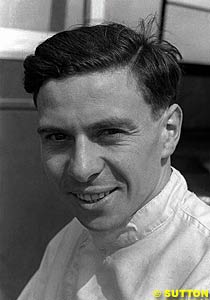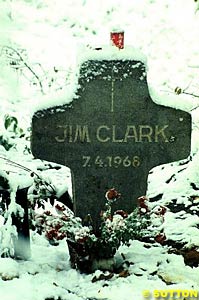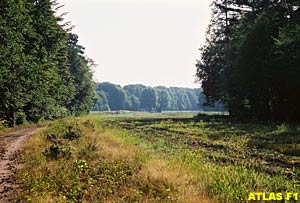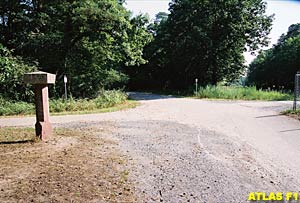
Atlas F1 Senior Writer
Jim Clark was killed at Hockenheim 35 years ago but you would never know it from a visit to the site of the German Grand Prix today. Due to a combination of indifference and neglect the location of the Jim Clark Memorial remains a big secret. Atlas F1's Thomas O'Keefe challenges Hockenheim-Ring GmbH to live up to its responsibility as trustee of the historic Jim Clark Memorial to manage the site with the respect it deserves
Instead of being at Brands Hatch driving the F3L, however, Jimmy was at a misty and damp Hockenheim trying to put a good face on the new Lotus F2 car now sponsored by Gold Leaf Tobacco, the Lotus 48, and though teammate Graham Hill was there too Clark was otherwise on his own. No Chapman, no girlfriend successor to Sally Stokes, no hangers on from Scotland, just a couple of mechanics that helped with the F2 Lotus at the previous F2 race at Barcelona and were also there with Jim Clark at Hockenheim.
Indeed, there are pictures that show Jimmy helping the mechanics pour in the fuel before the race at Hockenheim. There are other pictures of Jimmy looking at the Lotus 48 from the rear as if he was doing a pre-race inspection; it is said the mechanics were running Clark's car up and down in the paddock trying to cure a misfiring engine. Indeed, the rear suspension had been replaced at Hockenheim by one of the mechanics after Clark had been rear-ended in the Barcelona F2 race.
But time would run out before the Lotus 48 could be perfected and join its celebrated brethren - Lotus 18, 25, 33, 38 (the Indy car) and 49 - as more genius from the mind and pen of Colin Chapman. Instead of the Hockenheim F2 race being a shot in the arm for the fortunes of Lotus, the death of Jim Clark out in the forest at Hockenheim only tended to confirm the suspicions many people had about Lotuses - that they were fragile to the point of being dangerous, as drivers like Alan Stacey, Michael Taylor, Stirling Moss and Innes Ireland had learned, and as Mike Spence, Jim Clark and Jochen Rindt would discover in time.
When an Atlas F1 reader e-mailed the Hockenheimring management about this state of affairs last year, when the new track was being built and construction debris was being stored near the Memorial, the response from the track's management was revealing:
A year later, in 2003, and the Hockenheimring apparently still has no time to take care of the Jim Clark Memorial.
So Jim Clark is still alone at Hockenheim, except for those curious enough to wonder about the memorial, where it is and what has become of it. Last year, when the redesigned track was inaugurated, it was not well known except to some that the actual asphalt of the long straights, the Jim Clark Curve and all the rest were bulldozed, even during the 2002 German Grand Prix race weekend. This year, the evidence is clear in the area beyond Turn 2, known mellifluously as "Einfahrt Parabolika", that new trees have been planted on the ground bulldozed last year: there is no changing our mind on this one if we don't like the Herman Tilke track; there is no going back. The asphalt is gone forever and the trees are growing. In another 35 years it will all be forest again.
Where does that leave the Jim Clark Memorial? At least on race weekends, you can find it by walking along a road parallel to the straightaway of the new track between Turns 1 and 2. When you reach the perimeter of the new track you will see a built up earthen bank where the old track took off down the straightaway into the forest. Keep walking another five minutes after you leave the new track and you will come to an obvious crossroads, with a brown, permanent stone marker with distances and places engraved as to the surrounding towns.
By following this path for another 10 or 15 minutes, keeping the Hardtbachdamm on your left, the sounds of the V10 engines from the racetrack begin to fade, and you will pass by what was the former Jim Clark curve on your right, now all dug up, a chicane constructed after his accident to slow the cars down. After seeing the remains of the Jim Clark curve to your right, be on the lookout for four trees to the right of the Hardtbachdamm and between it and the old racetrack that stand out on the horizon: two normal looking pine trees and between those two trees, two smaller cypress trees close together.
When you see those cypress trees you are almost there. It is now 20 minutes from the edge of the current racetrack. There are bike route signs Routes 2 and 4, there is a park maintenance building named the "Greenhaus" near the Hardtbachdamm, but little else to distinguish or mark this area, which is a significant one in the history of Grand Prix racing.
What do you find today between the two low-lying cypress trees? A simple stone cross with only two pieces of information on it: "Jim Clark" and "7.4.1968", the date of the accident. The day I visited, a candle had been placed at the base of the cross. On top of the cross were the remains of a flower pot that had also been left some time ago. I kept thinking that I wished I had borrowed the flower setting on the table from lunch at the Ferrari motorhome and hiked it out to the memorial to spruce it up for Jimmy. At Imola, Senna's memorial is much more accessible to the public, located as it is on a still-active portion of the track across from the re-configured Tamburello curve and there are always flowers and other mementos adorning that memorial on race weekend.
What is to be done? The FIA's Alan Donnelly, a Scot himself and Max Mosley's representative at the races, thinks something should be done to rectify this neglect. Herbie Blash, an ex-Brabham mechanic when Bernie Ecclestone owned the team who is now the FIA's Observer at all the Grands Prix, makes his annual pilgrimage to the site for his own personal reasons, having nothing to do with his official duties, and is in a position to confirm the situation to the FIA.
Bernie Ecclestone was also not pleased to hear about the state of Clark's memorial and told me that he was going to check on it because he thought he paid for the upkeep of the Jim Clark Memorial. If so, he is uncharacteristically not getting his money's worth.
It is not so much the failure of upkeep and absence of flowers that bothers me, but the studied indifference of it all. At a minimum the Hockenheimring management ought to be asked to add a few "Jim Clark Memorial" signs to alert people to how to find the memorial so that it does not end up being lost and forgotten in the New Forest that is planned for the bed of the old track. The official Hockenheimring Map as of 2002 shows the new track and even refers to the Hardtbachdamm but I found no reference whatsoever on the map to the Jim Clark Memorial.
One final note. Although I have written in another article about my skepticism as to the official version of what happened to kill Jim Clark that day, actually seeing the spot only made me wonder all the more what really happened to him. As I suggested at the time, if you had three culprits to blame - Lotus, Firestone or Clark - your first choice would not be Jim Clark. Indeed, although a cut right rear Firestone was the working hypothesis as to the cause of the accident, the RAC Scrutineer who filed his report on the matter stated that "it [was] absolutely impossible to be categoric as to the possible reason for the accident."
When the Lotus 48 hit the saplings then planted on the low hillside and began to come apart, the terrain would have contributed to rupturing the Lotus, scattering its engine and suspension parts all over the landscape and killing Jimmy. He was apparently trapped and crushed in the cockpit as the tub wrapped itself around one of those trees, no Armo there then to protect a driver from a horrible accident like this that propelled, whatever the cause, the Lotus 48 into the trees.
When you go there now, there is one thing about the experience that is fitting for a memorial. It is an eerily quiet and peaceful place: no track, no Armo, no marshal stands, only the two cypress trees, the stone cross and trees silently growing as nature reclaimed her own.
Hopefully next year, now that the re-designed Hockenheimring is a success and the new tree farm is growing on the old straightaway, the Hockenheimring track management will find the time to let race fans know about the Jim Clark Memorial out there in the forest which, if properly managed, could become a kind of respectful pilgrimage for people so disposed, as is a visit to Tamburello at Imola.
On a happier note, however forgotten Jim Clark may be in the forests of Hockenheim, he is much remembered in his native Scotland and next week we tour the Jim Clark trail and see what remains of the place he lived and loved and where he is buried.
While I am thrilled that two years running we have had exciting Grands Prix at the Hockenheimring, I cannot even think of Hockenheim without also remembering Jim Clark and what happened to him at Hockenheim 35 years ago when he was killed on lap 5 of a Formula 2 race and the world lost one of its finest motor racing champions and the last of the gentlemen racers.
 That Sunday, April 7th 1968, he was unusually alone and bereft for a two-time World Champion, who today would be accompanied by an entourage of managers, physiotherapists and public relations flaks. Lotus chief Colin Chapman was off on a skiing holiday at St. Moritz and many of Clark's contemporaries and the motorsports journalists who covered them were a continent away at the 500-mile BOAC sports car race at Brands Hatch where Jimmy should have also been. Prior to a change of plans at the behest of Colin Chapman, Clark was scheduled to drive the experimental Ford F3L sports racer for Alan Mann Racing, a sleek confection painted red and gold that was supposed to replace the Ford GT40.
That Sunday, April 7th 1968, he was unusually alone and bereft for a two-time World Champion, who today would be accompanied by an entourage of managers, physiotherapists and public relations flaks. Lotus chief Colin Chapman was off on a skiing holiday at St. Moritz and many of Clark's contemporaries and the motorsports journalists who covered them were a continent away at the 500-mile BOAC sports car race at Brands Hatch where Jimmy should have also been. Prior to a change of plans at the behest of Colin Chapman, Clark was scheduled to drive the experimental Ford F3L sports racer for Alan Mann Racing, a sleek confection painted red and gold that was supposed to replace the Ford GT40.
 But my beef today is not with Hockenheim 1968 but with Hockenheim 2003. Why? Because while millions have been spent on new grandstands and to Herman Tilkenize the Hockenheim track by eliminating the long straights into the forest, the track organizers have abandoned Jim Clark entirely, not erecting even one sign anywhere on the track or in the environs thereof that lets the public know that out there in the exquisite, bucolic silence of a newly-planted forest there is a memorial to the Flying Scot that is at most 20 minutes walking distance from the racetrack itself.
But my beef today is not with Hockenheim 1968 but with Hockenheim 2003. Why? Because while millions have been spent on new grandstands and to Herman Tilkenize the Hockenheim track by eliminating the long straights into the forest, the track organizers have abandoned Jim Clark entirely, not erecting even one sign anywhere on the track or in the environs thereof that lets the public know that out there in the exquisite, bucolic silence of a newly-planted forest there is a memorial to the Flying Scot that is at most 20 minutes walking distance from the racetrack itself.
"The Jim Clark Memorial is not accessible for the normal publik. The old track … is a restricted area. Our will is that the memorial [will continue] standing on this place where Jim Clark was died. We think in 5 to 6 months this place will be wonderful, in the middle of the forest. Please understand, in this short time from January to July [2002] we had many problems with the completion of the new track and we had no time to take care of the Jim Clark Memorial." (Emphasis added)
 On the right of the stone marker is the old track and you could get to the Jim Clark Memorial by following the path of the old straightaway, but if you do that you would be trampling on the newly planted trees. Alternatively, and more responsibly, take a left at the stone marker and walk 20 yards towards a bridge you can see from the stone marker. Just before you get to the bridge take a right and walk along a beautiful path next to a fascinating and unusual terrain feature called the "Hardtbachdamm", which is really a wide ditch with water in it that is almost a canal and runs all along this area of forest, nearby the old straightaway and directly parallel to it.
On the right of the stone marker is the old track and you could get to the Jim Clark Memorial by following the path of the old straightaway, but if you do that you would be trampling on the newly planted trees. Alternatively, and more responsibly, take a left at the stone marker and walk 20 yards towards a bridge you can see from the stone marker. Just before you get to the bridge take a right and walk along a beautiful path next to a fascinating and unusual terrain feature called the "Hardtbachdamm", which is really a wide ditch with water in it that is almost a canal and runs all along this area of forest, nearby the old straightaway and directly parallel to it.
 Max Mosley, now President of the FIA, was driving the London Racing Team's Brabham BT23C in his first F2 race that day at Hockenheim and remembers this fateful spot as if it was yesterday, as he came upon the scene. "I just remember seeing the ambulance parked off to one side of the track … someone had obviously gone into the trees, and I remember catching Graham Hill and overtaking him, which was one of the high points of my career … It was wet … the tires on the two Team Lotus cars were inferior to the [Dunlops] I had."
Max Mosley, now President of the FIA, was driving the London Racing Team's Brabham BT23C in his first F2 race that day at Hockenheim and remembers this fateful spot as if it was yesterday, as he came upon the scene. "I just remember seeing the ambulance parked off to one side of the track … someone had obviously gone into the trees, and I remember catching Graham Hill and overtaking him, which was one of the high points of my career … It was wet … the tires on the two Team Lotus cars were inferior to the [Dunlops] I had."
 Blash's pilgrimage has to do with a promising New Zealand driver named Bert Hawthorne, who was killed near this same spot on April 14th 1972 - ironically during practice for the Jim Clark Trophy Race for F2 cars. Blash had just begun working as a Brabham mechanic in 1972 and he was sharing a flat with Hawthorne when he was killed, which is why Blash makes his way out there to the forest each year. A picture of 26 year-old Bert Hawthorne is placed on the ground and to the left of Jimmy's stone cross as a memorial to his passing, with the notation "Sadly Missed". So much for the Jim Clark curve/chicane which was constructed to make the place safer.
Blash's pilgrimage has to do with a promising New Zealand driver named Bert Hawthorne, who was killed near this same spot on April 14th 1972 - ironically during practice for the Jim Clark Trophy Race for F2 cars. Blash had just begun working as a Brabham mechanic in 1972 and he was sharing a flat with Hawthorne when he was killed, which is why Blash makes his way out there to the forest each year. A picture of 26 year-old Bert Hawthorne is placed on the ground and to the left of Jimmy's stone cross as a memorial to his passing, with the notation "Sadly Missed". So much for the Jim Clark curve/chicane which was constructed to make the place safer.
 Another feature that struck me is the modest distance between Jimmy coming onto the straight and the spot where the accident occurred, supposedly at 160 mph; it is not as far as I had imagined and I would have thought that the lone witness - a corner worker - would have seen more than is described in the official record filed by the RAC Scrutineer. I had also not realized the significance of the considerable terrain change just next to the track as it builds up to the raised area of the Hardtbachdamm, which presumably only added to the severity of the impact.
Another feature that struck me is the modest distance between Jimmy coming onto the straight and the spot where the accident occurred, supposedly at 160 mph; it is not as far as I had imagined and I would have thought that the lone witness - a corner worker - would have seen more than is described in the official record filed by the RAC Scrutineer. I had also not realized the significance of the considerable terrain change just next to the track as it builds up to the raised area of the Hardtbachdamm, which presumably only added to the severity of the impact.
Pictures provided by Jim Nesbitt and Bill Kemp
Please Contact Us for permission to republish this or any other material from Atlas F1.
|
Volume 9, Issue 33
Articles
The Next Generation
Forgotten in the Forest
Columns
Rear View Mirror
On the Road
Elsewhere in Racing
The Weekly Grapevine
> Homepage |